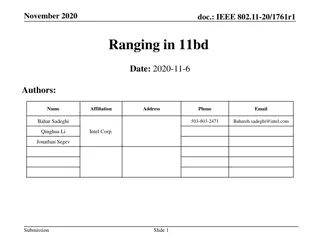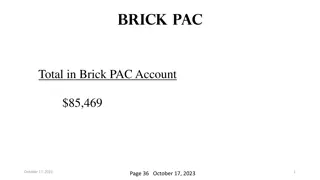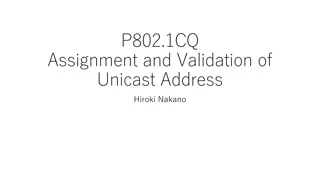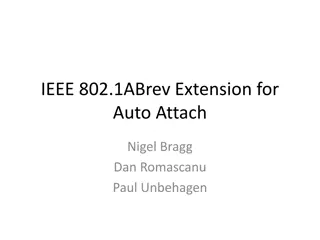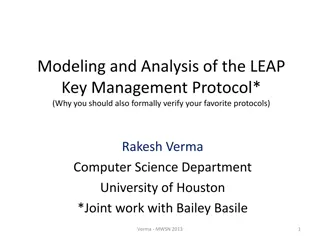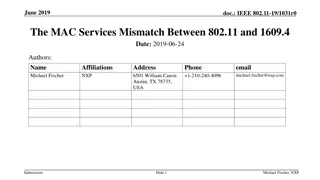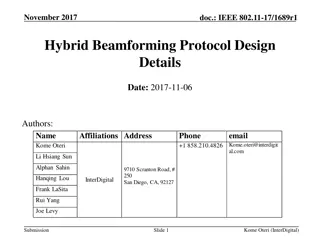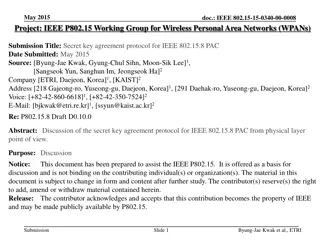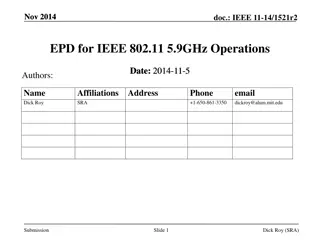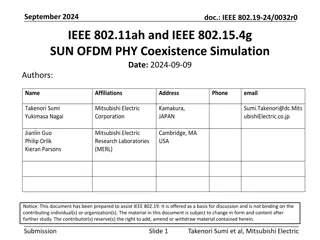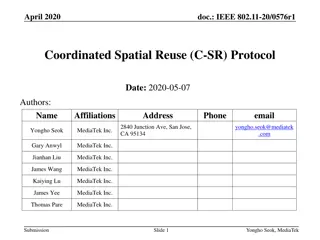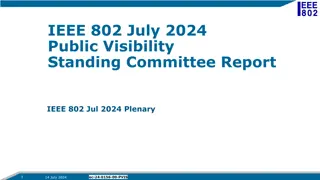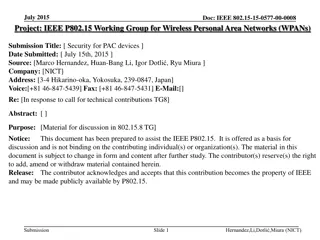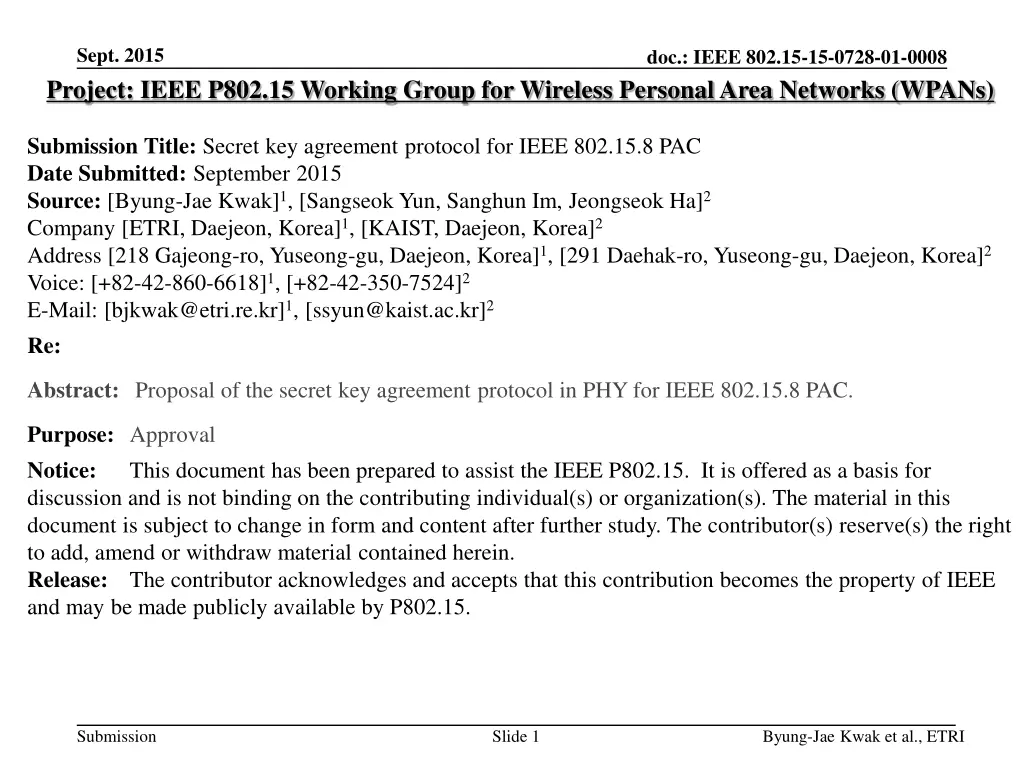
Secure Key Agreement Protocol for Wireless PAC
"Explore a secret key agreement protocol for IEEE 802.15.8 PAC using physical layer features. The document proposes methods for remote key sharing without a key management infrastructure, leveraging channel reciprocity and sequential key distillation."
Download Presentation

Please find below an Image/Link to download the presentation.
The content on the website is provided AS IS for your information and personal use only. It may not be sold, licensed, or shared on other websites without obtaining consent from the author. If you encounter any issues during the download, it is possible that the publisher has removed the file from their server.
You are allowed to download the files provided on this website for personal or commercial use, subject to the condition that they are used lawfully. All files are the property of their respective owners.
The content on the website is provided AS IS for your information and personal use only. It may not be sold, licensed, or shared on other websites without obtaining consent from the author.
E N D
Presentation Transcript
Sept. 2015 Project: IEEE P802.15 Working Group for Wireless Personal Area Networks (WPANs) doc.: IEEE 802.15-15-0728-01-0008 Submission Title: Secret key agreement protocol for IEEE 802.15.8 PAC Date Submitted: September 2015 Source: [Byung-Jae Kwak]1, [Sangseok Yun, Sanghun Im, Jeongseok Ha]2 Company [ETRI, Daejeon, Korea]1, [KAIST, Daejeon, Korea]2 Address [218 Gajeong-ro, Yuseong-gu, Daejeon, Korea]1, [291 Daehak-ro, Yuseong-gu, Daejeon, Korea]2 Voice: [+82-42-860-6618]1, [+82-42-350-7524]2 E-Mail: [bjkwak@etri.re.kr]1, [ssyun@kaist.ac.kr]2 Re: Abstract: Proposal of the secret key agreement protocol in PHY for IEEE 802.15.8 PAC. Purpose: Approval Notice: discussion and is not binding on the contributing individual(s) or organization(s). The material in this document is subject to change in form and content after further study. The contributor(s) reserve(s) the right to add, amend or withdraw material contained herein. Release: The contributor acknowledges and accepts that this contribution becomes the property of IEEE and may be made publicly available by P802.15. This document has been prepared to assist the IEEE P802.15. It is offered as a basis for Submission Slide 1 Byung-Jae Kwak et al., ETRI
Sept. 2015 doc.: IEEE 802.15-15-0728-01-0008 Secret key agreement protocol for IEEE 802.15.8 PAC Sept. 2015 Submission Slide 2 Byung-Jae Kwak et al., ETRI
Sept. 2015 doc.: IEEE 802.15-15-0728-01-0008 Most Popular Passwords 2012 password 123456 12345678 abc123 qwerty monkey letmein dragon 111111 baseball 2013 123456 Password 12345678 qwerty abc123 123456789 111111 1234567 iloveyou adobe123 2014 123456 password 12345 12345678 qwerty 123456789 1234 baseball dragon Football 1 2 3 4 5 6 7 8 9 10 Submission Slide 3 Byung-Jae Kwak et al., ETRI
Sept. 2015 doc.: IEEE 802.15-15-0728-01-0008 Introduction This document presents a secret key agreement protocol using physical layer features This document proposes a secret key distribution protocol using channel impulse responses By taking advantage of channel reciprocity and sequential key distillation, a pair of legitimate users can remotely share a secret key without resorting to a key management infrastructure Specified methods are proposed and expected performances are evaluated Submission Slide 4 Byung-Jae Kwak et al., ETRI
Sept. 2015 doc.: IEEE 802.15-15-0728-01-0008 General Secret Key Agreement Protocol Maurer proposed a new approach to generate a random sequence achieving the perfect security [1] The process of generating a shared secret key consists of 3 phases Information Reconciliation Randomness Sharing Privacy Amplification Share the common randomness between Alice and Bob Alice & Bob agree on an identical random sequence Hash function provides the perfect secrecy Channel response between Alice & Bob can be seen as the common randomness Submission Slide 5 Byung-Jae Kwak et al., ETRI
Sept. 2015 doc.: IEEE 802.15-15-0728-01-0008 Secret Key Agreement Protocol Channel Probing Alice (STA1) Bob (STA1) Randomness Sharing Protocol Channel Estimation Channel Estimation Quantizer Quantizer ????-bits ????-bits Syndrome Reconciliation Reconciliation Agree/Disagree Post Processing Protocol For Key Extraction ????-bits ????-bits ????+ ???? ????? ???? 1-bits Privacy Amplification (w/ compression) Privacy Amplification (w/ compression) ? ???? ????? ????-bits ? ???? ????? ????-bits Secret key, ? Secret key, ? Submission Slide 6 Byung-Jae Kwak et al., ETRI
Sept. 2015 doc.: IEEE 802.15-15-0728-01-0008 Randomness Sharing Protocol Mode 1 Mode 2 Alice Bob Alice Bob process process process Channel estimation ??,1, ??,2, , ??,? Channel estimation ??,1, ??,2, , ??,? process Channel estimation ??,1, ??,2, , ??,? Channel estimation ??,1, ??,2, , ??,? Extract distinctive feature (freq. time domain) ?,1, ?,2, , ?,? Extract distinctive feature Extract distinctive feature (freq. time domain) ?,1, ?,2, , ?,? Extract distinctive feature (freq. time domain) ?,1, ?,2, , ?,? process (freq. time domain) ?,1, ?,2, , ?,? ??= ?1,?2, ,??1 Quantization ?1,?2, ,??? Quantization ?1,?2, ,??? Quantization ?1,?2, ,??? Quantization ?1,?2, ,??? process process process ??= ?1,?2, ,??? ??= ?1,?2, ,??? process ??= ?1,?2, ,??? Stop probing if ???? ?=1 ??= ?1,?2, ,??? ? ?? Pass the latest ???? quantized bits Gathering Enough ????-bits Gathering Enough ????-bits Pass the latest ???? quantized bits Post Post processing processing ??= ?1, ,?? ??= ?1, ,?? ? = ?0,?1, ,?? : secret key ? = ?0,?1, ,?? : secret key Submission Slide 7 Byung-Jae Kwak et al., ETRI
Sept. 2015 doc.: IEEE 802.15-15-0728-01-0008 Randomness Sharing The reciprocity of the propagation channel [2] Used as a source of common randomness Spatial de-correlation assumption Channel responses are location-specific feature A secret key is extracted by exploiting random fluctuation of the wireless channel Pilot symbols are used for estimating channel For randomness sharing, pilot symbols are located at all subcarriers except DC and guard subcarriers (i.e. 52 subcarriers) Submission Slide 8 Byung-Jae Kwak et al., ETRI
Sept. 2015 doc.: IEEE 802.15-15-0728-01-0008 Channel Correlation Issue (1/2) Residual channel correlation [3] reports there exists a strong correlation in measurements observed by adversaries located greater than a half-wavelength away from legitimate devices. However, this work does not consider the effect of the large scale fading on the channel correlation Submission Slide 9 Byung-Jae Kwak et al., ETRI
Sept. 2015 doc.: IEEE 802.15-15-0728-01-0008 Channel Correlation Issue (2/2) If the large scale fading is included, there exist a strong correlation in RSSI observed by Bob and Eve To minimize the channel correlation, eliminating the large scale fading is essential Submission Slide 10 Byung-Jae Kwak et al., ETRI
Sept. 2015 doc.: IEEE 802.15-15-0728-01-0008 Hardware Experiment Center frequency : 5.2GHz (? = 5.6cm) The distance between Bob and Eve is 1m Alice moves arbitrarily around the indoor office Submission Slide 11 Byung-Jae Kwak et al., ETRI
Sept. 2015 doc.: IEEE 802.15-15-0728-01-0008 Hardware Experiment The channel correlation between the RSSI observed at each node after eliminating the large scale fading Channel Correlation Main channel 0.9661 Wiretap channel 0.0839 Submission Slide 12 Byung-Jae Kwak et al., ETRI
Sept. 2015 doc.: IEEE 802.15-15-0728-01-0008 Effect of Channel Correlation Mutual information between correlated random variables Let ?,? be random variables of normal distribution, and the correlation between ? and ? be ???, then ? = ? ? ? ;? ? ?;? = 1 2 2log 1 ??? where ? represents post processing function (by data processing inequality ) Ex) ???= 0.3, then ? = ? ? ? ;? 0.068 Submission Slide 13 Byung-Jae Kwak et al., ETRI
Sept. 2015 doc.: IEEE 802.15-15-0728-01-0008 Randomness Sharing (1/3) Subcarrier allocation Both of channel amplitude and phase can be quantized We use BPSK 52 Pilot subcarriers Guard subcarriers Left 26 Right 26 64 Subcarriers DC subcarrier Submission Slide 14 Byung-Jae Kwak et al., ETRI
Sept. 2015 doc.: IEEE 802.15-15-0728-01-0008 Randomness Sharing (2/3) ITU Pedestrian B Channel Model Channel between Alice and Bob is highly correlated Submission Slide 15 Byung-Jae Kwak et al., ETRI
Sept. 2015 doc.: IEEE 802.15-15-0728-01-0008 Randomness Sharing (3/3) IEEE 802.11 Channel Model Channel between Alice and Bob is highly correlated Submission Slide 16 Byung-Jae Kwak et al., ETRI
Sept. 2015 doc.: IEEE 802.15-15-0728-01-0008 Secret Key Agreement Protocol Channel Probing Alice (STA1) Bob (STA1) Randomness Sharing Protocol Channel Estimation Channel Estimation Quantizer Quantizer ????-bits ????-bits ?? ?? Syndrome Reconciliation Reconciliation Agree/Disagree Post Processing Protocol For Key Extraction ????-bits ????-bits ????+ ???? ????? ???? 1-bits Privacy Amplification (w/ compression) Privacy Amplification (w/ compression) ? ???? ????? ????-bits ? ???? ????? ????-bits Secret key, ? Secret key, ? Submission Slide 17 Byung-Jae Kwak et al., ETRI
Sept. 2015 doc.: IEEE 802.15-15-0728-01-0008 Common Key Extraction Protocol Information reconciliation Random bit sequence for extracting secret key is obtained from channel impulse responses with quantization In the quantization process, the random bit sequences at legitimate parities may have discrepancy Such discrepancy can be removed by performing the information reconciliation [4, 5] Submission Slide 18 Byung-Jae Kwak et al., ETRI
Sept. 2015 doc.: IEEE 802.15-15-0728-01-0008 Information Reconciliation (1/3) Error correction code based reconciliation 1) Determine field size ? : ????< 2? 1 2) Estimated discrepancy ????between ?? and ?? is determined by SNR, quantization method and margin 3) Given ? = 2? 1 and ? = ????, calculate the necessary number of parity ???? 4) If ????+ ???? ?, concatenate sequence ?? and ?????= ? ???? ???? bit zero-padding sequence (shortening). 2? 1 ???? ???? ????? 2? 1 1 Submission Slide 19 Byung-Jae Kwak et al., ETRI
Sept. 2015 doc.: IEEE 802.15-15-0728-01-0008 Information Reconciliation (2/3) Error correction code based reconciliation 5) Else, repeat from 3) with increased ? 2? 1 ???? ???? 2? 1 1 ? = ? + 1 2? 1 ???? ???? ????? 2? 1 1 6) Encode the extended message with systematic BCH (?,?,?) ? = ????+ ?????+ ????, ? = ????+ ?????, ? = ???? Submission Slide 20 Byung-Jae Kwak et al., ETRI
Sept. 2015 doc.: IEEE 802.15-15-0728-01-0008 Information Reconciliation (3/3) Error correction code based reconciliation 7) Alice sends parity parts of the codeword to Bob using public perfect channel 8) If the number of discrepancy is smaller than error correction capability, i.e. ???? ?, the errors in the sequence can be corrected. 9) Then the legitimate parties have exactly same sequence ? Submission Slide 21 Byung-Jae Kwak et al., ETRI
Sept. 2015 doc.: IEEE 802.15-15-0728-01-0008 Secret Key Agreement Protocol Channel Probing Alice (STA1) Bob (STA1) Randomness Sharing Protocol Channel Estimation Channel Estimation Quantizer Quantizer ????-bits ????-bits ?? ?? Syndrome Reconciliation Reconciliation Agree/Disagree Post Processing Protocol For Key Extraction ????-bits ????-bits ? ????+ ???? ????? ???? 1-bits Privacy Amplification (w/ compression) Privacy Amplification (w/ compression) ? ???? ?????-bits ? ???? ?????-bits Secret key, ? Secret key, ? Submission Slide 22 Byung-Jae Kwak et al., ETRI
Sept. 2015 doc.: IEEE 802.15-15-0728-01-0008 Privacy Amplification (1/9) Privacy amplification The parity part of the codeword is also open to the eavesdropper during public discussion There must be an additional procedure aiming to extract secret key of which the eavesdropper is totally ignorant Submission Slide 23 Byung-Jae Kwak et al., ETRI
Sept. 2015 doc.: IEEE 802.15-15-0728-01-0008 Privacy Amplification (2/9) The number of disclosed bits Syndrome vector is determined by column combination of parity check matrix with received codeword Since the last ? ? bit of the codeword, i.e. the parity is disclosed to Eve, there will be an equivocation of ? bits ? ? ? ? ? ? ? ? = Ambiguous part ? ? Syndrome Parity check matrix Disclosed part Submission Slide 24 Byung-Jae Kwak et al., ETRI
Sept. 2015 doc.: IEEE 802.15-15-0728-01-0008 Privacy Amplification (3/9) The number of disclosed bits The parity check matrix of BCH code is full rank (i.e. it can be reduced by row/column permutation) The equivocation is reduced from ? bits to 2? ? bits, i.e. ? ? bits are leaked to Eve ? ? ? ? ? ? ? 2? ? Reducible part ? ? ? ? = Ambiguous part ? ? Syndrome Parity check matrix Disclosed part Submission Slide 25 Byung-Jae Kwak et al., ETRI
Sept. 2015 doc.: IEEE 802.15-15-0728-01-0008 Privacy Amplification (4/9) Privacy amplification The number of disclosed bits during public discussion is ? ? = ???? Moreover, because of the channel correlation, ????? bits are disclosed during randomness sharing process ?????= ?????+ ???? Submission Slide 26 Byung-Jae Kwak et al., ETRI
Sept. 2015 doc.: IEEE 802.15-15-0728-01-0008 Privacy Amplification (5/9) Privacy amplification The leaked information about the shared sequence can be removed by using universal hash function Ex) the disclosed bit information is eliminated by binary summation 1 ? 1 bit equivocation over 2 bit 1 bit equivocation over 1 bit ? Submission Slide 27 Byung-Jae Kwak et al., ETRI
Sept. 2015 doc.: IEEE 802.15-15-0728-01-0008 Privacy Amplification (6/9) Privacy amplification Privacy amplification can be performed with universal hash function (Toeplitz matrix) [6][7] Suppose that Alice and Bob have ???? bits after error correction and Eve knows ????? bits Choose ???? as a security parameter Applying universal hash function ? ? ?,?: 0,1???? 0,1????,????= ???? ?????+ ???? The remained mutual information about whole secret key after privacy amplification is less than 2 ???? ln 2 Submission Slide 28 Byung-Jae Kwak et al., ETRI
Sept. 2015 doc.: IEEE 802.15-15-0728-01-0008 Privacy Amplification (7/9) Privacy amplification Submission Slide 29 Byung-Jae Kwak et al., ETRI
Sept. 2015 doc.: IEEE 802.15-15-0728-01-0008 Privacy Amplification (8/9) Privacy amplification Alice (or Bob) transmits randomly generated ????+ ???? ????? ???? 1 bit sequence Alice and Bob generate ???? ???? ????? ???? Toeplitz matrix ? and eliminating the disclosed bits by calculating ? = ?? Then the legitimate parties have exactly same ???? bit secret key ? ???? ????? Submission Slide 30 Byung-Jae Kwak et al., ETRI
Sept. 2015 doc.: IEEE 802.15-15-0728-01-0008 Privacy Amplification (9/9) Correlation elimination In slow fading channel, channel observation between two adjacent subcarriers are correlated To guarantee perfect security, these correlation should be eliminated Entropy coding is performed to eliminate the correlation between observed sequence Huffman coding with a dictionary generated by empirical distribution of quantized bits Let ? is compression efficiency The length of final key ? is ? ???? ????? ???? Submission Slide 31 Byung-Jae Kwak et al., ETRI
Sept. 2015 doc.: IEEE 802.15-15-0728-01-0008 Information Leakage Channel Probing Alice (STA1) Bob (STA2) Randomness Sharing Protocol Channel Estimation Channel Estimation The amount of information disclosed to Eve Quantizer Quantizer ????-bits ????-bits ?????-bits ?????-bits Syndrome ?????+ ????-bits Reconciliation Reconciliation Agree/Disagree ????-bits Post Processing Protocol For Key Extraction ????-bits ????-bits ????+ ???? ????? ???? 1-bits Privacy Amplification (w/ compression) Privacy Amplification (w/ compression) ? ???? ????? ????-bits 0-bits Secret key, ? Secret key, ? Submission Slide 32 Byung-Jae Kwak et al., ETRI
Sept. 2015 doc.: IEEE 802.15-15-0728-01-0008 Performance of Proposed Protocol Experiment results based on computer simulation Submission Slide 33 Byung-Jae Kwak et al., ETRI
Sept. 2015 doc.: IEEE 802.15-15-0728-01-0008 Experimental Environment (1/2) Experiment setup ITU Ped. B / IEEE 802.11 channel model IEEE 802.15.8 Low-mobility PHY parameters The target secret key length per 10 packet exchanges (including post-processing) is 128 bits Starting with 6 consecutive observations (i.e. ????= 312 = 52 6) Randomness sharing Quantizing channel frequency response 1bit quantization is performed in 1 subcarrier (to be optimized with SNR) Submission Slide 34 Byung-Jae Kwak et al., ETRI
Sept. 2015 doc.: IEEE 802.15-15-0728-01-0008 Experimental Environment (2/2) Experiment setup Information reconciliation Shortened BCH code Overestimated parity bit (lower bound on secret key rate) Privacy amplification Universal hash function (Toeplitz matrix) is applied with the security parameter ????= 10 Residual channel correlation is assumed 0.3 ? = 0.068 Correlation elimination Entropy coding (Huffman coding) Submission Slide 35 Byung-Jae Kwak et al., ETRI
Sept. 2015 doc.: IEEE 802.15-15-0728-01-0008 Simulation Results Target key length SNR Submission Slide 36 Byung-Jae Kwak et al., ETRI
Sept. 2015 doc.: IEEE 802.15-15-0728-01-0008 Conclusion It is possible for legitimate terminals to share a 128-bit secret key in fully distributed network by exploiting the channel reciprocity and the post processing within 10 packet exchanges 128-bit secret key is strong enough to encrypt secret message [8] It is expected that secret key extraction rate can be further increased when we optimize the proposed method using channel information Submission Slide 37 Byung-Jae Kwak et al., ETRI
Sept. 2015 doc.: IEEE 802.15-15-0728-01-0008 Motion Accept the text proposal in DCN 15-15- 727-01-0008 to be added to P802.15.8 PAC Draft D0.14.0. Submission Slide 38 Byung-Jae Kwak et al., ETRI
Sept. 2015 doc.: IEEE 802.15-15-0728-01-0008 References [1] U. Maurer, Secret key agreement by public discussion from common information, IEEE Tans. Information Theory, vol. 39, pp. 733-742, May 1993. [2] G. S. Smith, A direct derivation of a single-antenna reciprocity relation for the time-domain, IEEE Trans. Antennas Propagate., vol. 52, no. 6, pp. 1568-1577, Jun. 2004. [3] Matthew Edman, Aggelos Kiayias, Bulent Yener, On Passive Inference Attacks Against Physical-layer Key Extraction, EUROSEC 11, 2011. [4] C. H. Bennett, E. Bessette, G. Brassard, L. Salvail and J. Smolin, Experimental quantum cryptography, Journal of Cryptography, vol. 5, no. 1, pp. 3-28, 1992. [5] G. Brassard and L. Savail, Secret-key reconciliation by public discussion, In Advances in cryptology EUROCRYPT 93, Lecture Notes in Computer Science, vol. 765, pp. 410-423, Springer-Verlag, New York, 1994. [6] Chi-Hang Fred Fung, Xiongfeng Ma, H. F. Chau, Practical issues in quantum-key-distribution post-processing, arXiv:0910.0312 [7] Hui, Qiao, Xiao-yu Chen, Simulation of BB84 Quantum Key Distribution in depolarizing channel, proc. In 14th Youth Conference on Communication, 2009 [8] Seagate, 128-Bit Versus 256-bit AES Encryption, http://www.axantum.com/AxCrypt/etc/seagate128vs256.pdf Submission Slide 39 Byung-Jae Kwak et al., ETRI






